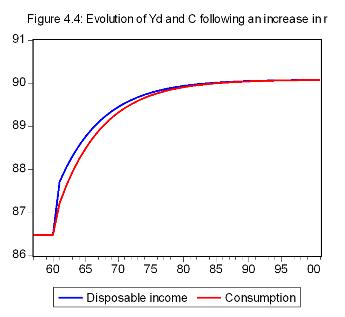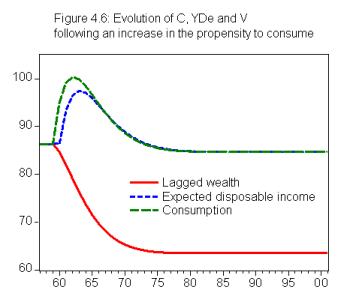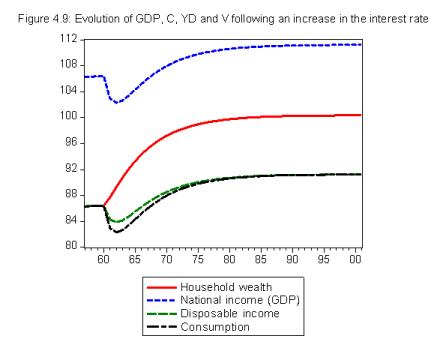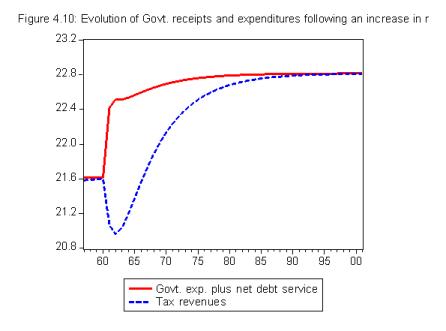Chapter 4. Government money with portfolio choice
Model PC - Model PCEX - Model PCEX1 - Model PCEX2 - Model PCNEO
Model PC
Model PC incorporates government bills and asset demand functions. The chart shows the impact of a rise in the
interest rate on disposable income and consumption.
Download: gl04pc (Eviews 5 to 8)
or gl04pc_v4 (Eviews 4.1)

model pc_mod
' Add equations to model PC
' Determination of output - eq. 4.1
pc_mod.append y = cons + g
' Disposable income - eq. 4.2
pc_mod.append yd = y - t + r(-1)*b_h(-1)
' Tax payments - eq. 4.3
pc_mod.append t = theta*(y + r(-1)*b_h(-1))
' Wealth accumulation - eq. 4.4
pc_mod.append v = v(-1) + (yd - cons)
' Consumption function - eq. 4.5
pc_mod.append cons = alpha1*yd + alpha2*v(-1)
' Cash money - eq. 4.6
pc_mod.append h_h = v - b_h
' Demand for government bills - eq. 4.7
pc_mod.append b_h = v*(lambda0 + lambda1*r - lambda2*(yd/v))
' Supply of government bills - eq. 4.8
pc_mod.append b_s = b_s(-1) + (g + r(-1)*b_s(-1)) - (t + r(-1)*b_cb(-1))
' Supply of cash - eq. 4.9
pc_mod.append h_s = h_s(-1) + b_cb - b_cb(-1)
' Government bills held by the central bank - eq. 4.10
pc_mod.append b_cb = b_s - b_h
' Interest rate as policy instrument - eq. 4.11
pc_mod.append r = r_bar
Model PCEX
Model PCEX introduces expectations on households disposable income, where expectations are altered by random shocks.
Download: gl04pcex (Eviews 5 to 8)
or gl04pcex_v4 (Eviews 4.1)
Note that the macro generates a new series for the random shock each time it is executed: you will get different charts
every time, but the model will keep its properties.
Check that the missing equation, Hh = Hs, holds for any model solution.
|
 |
Model PCEX1
Model PCEX1 modifies the previous model, by using adaptive expectations Yde = Yd.
Download: gl04pcex1 (Eviews 5 o 8)
or gl04pcex1_v4 (Eviews 4.1)
This model is used in par.4.6.2 to analyze the effects of a change in the propensity to consume out of disposable income.
Model PCEX2
Model PCEX2 modifies model PCEX1, by assuming that the propensity to consume out of disposable income depends
inversely on the interest rate α1 = α10 - ι · r.
Download: gl04pcex2 (Eviews 5 to 8)
or gl04pcex2_v4 (Eviews 4.1)
This model is used in par.4.6.3 to analyze the effects of a change in the the interest rate.
Model PCNEO
Model PCNEO assumes a "Neoclassical" closure, by exogenizing demand for securities from the Central bank, and making the interest
rate endogenous.
Download: gl04pcneo (Eviews 5 to 8)
or gl04pcneo_v4 (Eviews 4.1)
Note how equation 4.7 has been changed to solve for the rate of interest on bills.
model pcneo_mod
' Add equations to model PCNEO
' Determination of output - eq. 4.1
pcneo_mod.append y = cons + g
' Disposable income - eq. 4.2
pcneo_mod.append yd = y - t + r(-1)*b_h(-1)
' Tax payments - eq. 4.3
pcneo_mod.append t = theta*(y + r(-1)*b_h(-1))
' Wealth accumulation - eq. 4.4
pcneo_mod.append v = v(-1) + (yd - cons)
' Consumption function - eq. 4.5
pcneo_mod.append cons = alpha1*yd + alpha2*v(-1)
' Cash money - eq. 4.6
pcneo_mod.append h_h = v - b_h
' Equilibrium interest rate, from the demand for government bills - eq. 4.7
pcneo_mod.append r = (b_h/v - (lambda0 - lambda2*(yd/v)))/lambda1
' Supply of government bills - eq. 4.8
pcneo_mod.append b_s = b_s(-1) + (g + r(-1)*b_s(-1)) - (t + r(-1)*b_cb(-1))
' Government bills held by households - eq. A4.3.3
pcneo_mod.append b_h = b_s - b_cb





